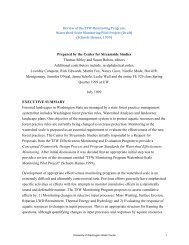Copyright 2012 Aileen M. Echiverri-Cohen - University of Washington
Copyright 2012 Aileen M. Echiverri-Cohen - University of Washington
Copyright 2012 Aileen M. Echiverri-Cohen - University of Washington
You also want an ePaper? Increase the reach of your titles
YUMPU automatically turns print PDFs into web optimized ePapers that Google loves.
There were four types <strong>of</strong> startle stimuli trials: 1) 50 ms 105 dB noise burst presented alone; 2) 50<br />
ms 105 dB noise burst, followed after 30 ms by a 25 ms 75 dB tone; 3) 50 ms 105 dB noise,<br />
followed after 60 ms by a 25 ms 75 dB tone; and 4) 50 ms 105 dB noise, followed after 120 ms<br />
by a 25 ms 75 dB tone. The four types <strong>of</strong> startle stimuli trials were repeated 20 times each, for a<br />
total <strong>of</strong> 80 repetitions. The order <strong>of</strong> the four trial types were randomized with the constraint that<br />
the same type <strong>of</strong> trial could not occur more than twice in succession. The recording session was<br />
initiated by a startle-alone trial on the first and last trial. Between trials or inter-trial intervals<br />
ranged from 15 s to 35 s (mean 25 s). In summary, there were a total <strong>of</strong> 80 startle trials that<br />
consisted <strong>of</strong> two blocks <strong>of</strong> 40 each, over a period <strong>of</strong> 20-30 min.<br />
Physiological recording <strong>of</strong> orbicularis oculi electromyogram (EMG) were controlled by<br />
Coulbourn Instruments Labline LLC (Model v15-17) and acquired by Windaq s<strong>of</strong>tware 01-720<br />
v.2.72. A set <strong>of</strong> 4 mm, silver/silver chloride sensors (EMG) were placed below the left eye,<br />
directly below the pupil and 13 mm apart to measure contraction <strong>of</strong> the orbicularis oculi muscle,<br />
and a ground electrode was placed on the center <strong>of</strong> the forehead. EMG was filtered with low<br />
frequency cut<strong>of</strong>fs <strong>of</strong> 90 Hz and high frequency cut<strong>of</strong>fs <strong>of</strong> 1000 Hz.<br />
Treatments<br />
Prolonged exposure (PE; Foa, Hembree, & Dancu, 2002) consisted <strong>of</strong> 10 weekly 90-120<br />
min individual sessions with study therapists that were either Master's or Ph.D. level trained<br />
clinical psychologists. Session 1 involved an overview <strong>of</strong> the treatment program, rationale for<br />
exposure, and instructions on breathing retraining. Session 2 consisted <strong>of</strong> psychoeducation about<br />
common reactions to trauma, and development <strong>of</strong> an in vivo exposure hierarchy that involves<br />
setting up a list <strong>of</strong> avoided trauma-related activities, situations, and places. Sessions 3-9 focused<br />
on imaginal exposure to the trauma memory and continued in vivo exposure. Clients are<br />
23
















